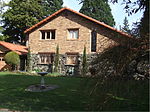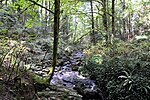Lake Oswego Transit Center
Lake Oswego, OregonPages with no open date in Infobox stationTransportation in Clackamas County, OregonTriMet transit centers

The Lake Oswego Transit Center is a transit center operated by TriMet, at 4th Street and A Avenue in Lake Oswego, Oregon.The following bus routes serve the transit center: 35 – Macadam/Greeley 36 – South Shore 37 – Lake Grove 78 – Beaverton/Lake OswegoIn 2002, an overhaul was planned due to the proliferation of pedestrian obstacles. At that time, the four bus lines serving the center picked up 593 passengers and dropped off 505 on an average weekday.Low ridership for two of the four bus lines serving the transit center (the 36 and 37, connecting Lake Oswego with Tualatin) was a concern for TriMet in the 2000s.
Excerpt from the Wikipedia article Lake Oswego Transit Center (License: CC BY-SA 3.0, Authors, Images).Lake Oswego Transit Center
4th Street,
Geographical coordinates (GPS) Address Nearby Places Show on map
Geographical coordinates (GPS)
| Latitude | Longitude |
|---|---|
| N 45.42029 ° | E -122.668 ° |
Address
4th Street
97034 , Forest Hills - First Addition
Oregon, United States
Open on Google Maps









